Check out our range of stock.
Didn't find what you like?
Send us a message
Found something out of stock?
Send us a message

The Kyubi Strain is a new strain of Bettas developed by the Indonesians. It comprises the halfmoon gene and the extreme webbing to make it look like feathers. Specimens such as these are still rare in the hobby and we believe these are a great addition to any Betta Connisaur. Stock is extremely limited and you will be getting personal videos of the one you can choose. Buy with confidence! Are these Betta tails cut? No fortunately they are not. Cutting or grooming for competition was the norm in Indonesia and Thailand around 10 years ago and they are frowned upon by the betta community both nationally and internationally now. These fish has been selectively bred from Rosetails and Feathertails Do you crop your photos? Yes we sure do. Do you have proof that these are natural? Yes we sure do. The above are videos of 4 week old fish The fish we import are 12 weeks old I am still not convinced. Do I get a guarantee? Yes you do we are going to hold sales of these until end of July 2024. If they do indeed grow back we will advise accordingly. If they don't we will also announce it as well In 24th June 2024 I have placed all sales of this strain on hold to understand if the fins regrow.. or not.
$20.00

Corydoras Hastatus is one of 3 nano Corydoras species with the most common being Pygmaeus and Habrosus. Corydoras Hastatus is now considered to one of the rarest and hardest to breed of the 3 species with their breeding patterns unlike any of the other 2 species. The Corydoras Hastatus that we are exclusively and privileged to get are bred here in Australia and they are strong. Unfortunately though they are a very hard species to breed and the demand of them will be high it is not a species that we can get in often. In any given year we can get around 30 pieces max. This is a great species best kept in nano tanks and with a minimum group of 3. Temperature: 20 – 26 °C pH: 6.0 – 7.5 Hardness: 36 – 215 ppm In other words. Easy to take care of. Very tolerant to a wide range of conditions. A real beginners' fish
$100.00

Sweet Gum Balls are sold in groups of 6. Botanicals not only enhance the visuals of your aquarium but also bring a bunch of extra benefits such as: Releasing tannins. Help lower pH. Aid in disease prevention, both bacterial and fungal. Provide an excellent environment for biofilm and microorganisms to grow, which provides microscopic foods for fry, shrimp, apistogrammas other small fish. Enhance a natural behaviour in your fish. All our botanicals are prepared carefully, being boiled and dried out with any seeds being removed as best as we can.
$4.95

Syngonium in an aquarium is a great way to bring an exotic touch to any freshwater aquarium. This easy-to-care-for plant is native to Central and South America and comes in a variety of colors and shapes. The arrowhead-shaped leaves can range from bright green to deep bronze and cream, with interesting variegation. It grows quickly so it's a great choice for filling in open areas. Syngonium prefers low light, so it can be kept in a variety of lighting conditions. It's a great choice for beginners and is easily propagated by dividing the stems. Syngonium is a beautiful addition to any aquarium and will provide a splash of color and texture.
$15.00

Syngonium is a genus of tropical and subtropical plants that are popular in the aquarium hobby. The most commonly used species in aquariums is Syngonium podophyllum, which is also known as the Arrowhead plant. In an aquarium, Syngonium plants are typically used for their aesthetic appeal and their ability to absorb excess nutrients from the water, which can help to improve water quality. Syngonium plants are a type of epiphytic plant, which means that they can grow without being rooted in soil. Instead, they can attach themselves to rocks, driftwood, or other decorations in the aquarium. Syngonium plants have heart-shaped leaves that can vary in color, from green to variegated shades of green and white. One of the benefits of using Syngonium plants in an aquarium is their ability to absorb excess nutrients from the water. This can help to reduce the levels of nitrates and phosphates, which can be harmful to fish and other aquatic inhabitants if they are present in high levels. Additionally, Syngonium plants can help to improve water clarity by absorbing particulate matter from the water. Syngonium plants are also popular in aquascaping because of their aesthetic appeal. They can be used to create a natural-looking environment in the aquarium and can add a pop of color to an otherwise dull aquascape. Syngonium plants can be used as a foreground or midground plant, and can be grown both emersed (with their leaves above the water) and submersed (with their leaves below the water). In terms of care, Syngonium plants are relatively easy to grow and require moderate lighting and regular fertilization. They can be propagated by taking stem cuttings and rooting them in the substrate or by attaching them to decorations in the aquarium. Overall, Syngonium plants are a versatile and attractive addition to any aquarium, and can provide both aesthetic and functional benefits.
$14.95

Size:6.1″*1.2″*0.8″Weight:100gSalt Range: 0-9990ppm or 0.000-0.999%Temperature Range: 1-50 °CMaterial: ABS new materialPackage include:1pcs Tester Description:Works ONLY for Salt Water Pool and Koi Fish Pond Salt level testing!NOT waterproof! No calibration needed This is used primarily for Crystal Red Shrimps as they need a TDS of 100 – 180 PLEASE NOTE THAT THIS DOES NOT COME WITH BATTERIES
$15.95

The amazing Texas Holey Rock is great for Alkaline Tolerant fish, particularly Cichlids and Marine. a Natural Calcium Carbonate Rock, full of holes and comes in an assortment of sizes. Nano Tanks Australia uses Texas Holy Rock as a buffer for our tanks. We do not use them as the base layer for tanks with African Cichlids as this is not our niche. When you are getting this product please note that our rocks come in 500g to 10kg pieces and we encourage you to consider what you are after. If you have doubts or further questions, please do not hesitate to contact us first and let's connect via Facebook. PLEASE MAKE SURE THAT YOU ADVISE US OF YOUR REQUIREMENTS USING THE NOTES SECTION UPON CHECKOUT.
$10.00
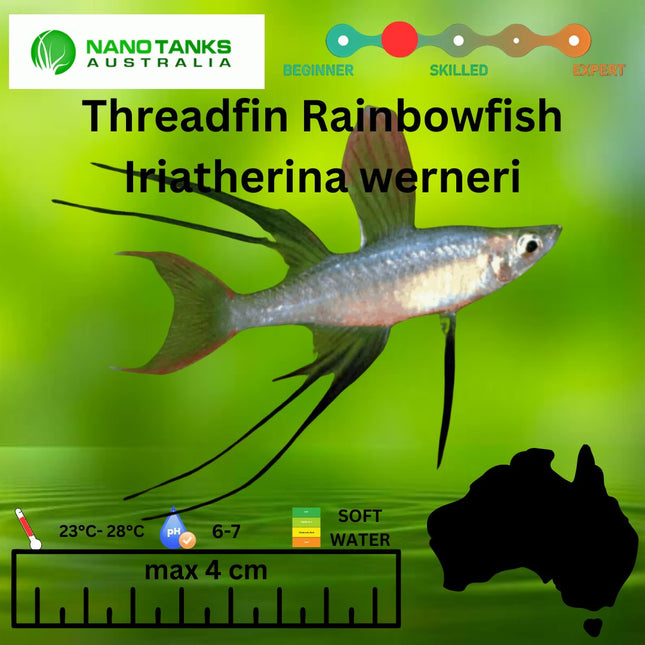
Threadfin Rainbowfish Iriatherina werneriGeneral information: The threadfin rainbowfish is a small unusual fish with a long thin body and a very small mouth. The males are easily recognised by long feathery fins when mature and grow to an approximate total length of 6 cm. Females are smaller and grow to approximately 4cm total length. The Gulbuwangay River form has nice colouration, black fins with some yellow at the base of the second dorsal fin and anal fin with the first dorsal fin black containing a reasonable proportion of red. The body is silvery brown sometimes with several darker vertical bands. Broosdstock were collected in a billabong adjacent the village of Mirrngatja. The threadfin rainbowfish were close to this vegetation and seen in schools, some of which were quite long, to three meters containing many fish. The water quality from the collection site was measured each time the area was visited. Collections were made during the dry season. The dry season coincides with southern winter. Daytime temperatures are similar to the wet season but the humidity levels are lower and night time temperatures are about ten deg C lower. The water was quite warm at 30 deg C. The pH average was 6.1. These measurements would be quite different in the wet season but not what you might expect. Temperature of the water may be lower, the pH higher and hardness/alkalinity levels lower. The natural diet of this fish is not known but it is believed to be mainly a carnivore eating small crustaceans and aquatic insects. It has not been observed eating algae or other plant material like other rainbows. No spawning behaviour had been observed in wild fish during the collections. The use of this small fish as an aquaculture species has been done with an arrangement between Aquagreen and Traditional Owner of the area. It is a project that falls under the banner of Sustainable use of a natural resource as a conservation tool, where some monies from the sale of cultured specimens is returned to the land owners to assist with land management practises.Cultivation notes : The adults are a schooling species so aquarium size is best 60cm or larger to house as many as possible but it is recommended a minimum of six. A magnificent set up for these fish is a large school of 80 to a 100 in a well planted 183cm x 61cm x 61cm (6 x 2 x 2 feet) aquarium. The aquarium is best set up with plenty of open swimming area and a tall background plants to the surface and either very short groundcover plant or plain gravel. The water these fish are produced at Aquagreen is usually about 27 to 30 deg C, pH about 6.5 to 7.0, carbonate hardness approx 60ppm, hardness approx 50ppm. These fish are cultured in ponds using natural plankton supplemented with commercial foods. They will take small portions of prepared foods but are best fed with live foods at least twice a week, more if possible. These fish will spawn readily in the aquarium, they are egg scatters and have small eggs that stick to the aquatic vegetation. They take several days to hatch and are quite small, they can be raised with commercial fry starter foods and plankton culture. These are a small delicate species that does not fare well with too much competition. They are best kept with smaller peaceful species such as blue-eyes.Distribution : Recorded from several places in North Queensland, Central Arnhem Land in the Northern Territory and in Southern New Guinea.Selling details : Sold individually at 2.5 centimetres total length.Reference: Allen G.R., Midgley S.H. and Allen M. (2002) "Freshwater Fishes of Australia"] ANGFA database - http://db.angfa.org.au
$20.00

Trichogaster trichopterus (Pallas, 1777)COMMON NAME: Blue gourami, three-spot gourami.SYNONYMS: Labrus trichopterus Pallas, 1777; Trichogaster trichopterus Bloch and Schneider, 1801; Trichopodas trichopterus Lacépède, 1801; Trichopus trichopterus Cuvier and Valenciennes 1831; Trichopus sepat Bleeker, 1845; Osphromenus siamensis Günther, 1861; Trichopus siamensis Sauvage, 1881; Osphronemus saigonensis Borodin, 1930.The numerous synonyms can be explained in part by the fact that many local forms deviating somewhat from each other were originally described as speciesLENGTH: 5 in. (12 cm)FIN RAY COUNT: D, VII-IX/8-10; A, X-XII/33-38.DISTRIBUTION: The species is very common throughout Indochina and the Malayan area (see map). Occurrences in the marginal areas of its distribution came about by releases. This species is quite variable over its large geographical range, and there are a large number of local forms. A detailed taxonomic study of these local forms has not yet been undertaken. Up to now only a mottled blue form from Sumatra has been described as a subspecies. This fish occurs in almost all types of waters but is very common in overgrown river banks, canals, ponds, and lakes in which there is an abundance of vegetation. It also lives periodically in flooded rice paddies and is even temporarily found in brackish water.DESCRIPTION: Typical coloration consists of two dark spots, one of which is in the centre of the side, and the other is located on the caudal peduncle. The common name, three-spot gourami, is derived from these the spots plus the dark eye, which is considered the third "spot." The basic colour and the markings can be quite different, depending on the place of origin of the specimens. Some individuals have a beautifully marbled pattern on a bluish grey or greenish grey background. Others are monochromatically bluish grey, but there's also a strain that has a more brownish background.The dorsal fin in the male is considerably longer and more pointed than that of the female. The anal fin is bigger on the male and marked on the outer edge by rows of iridescent orange or yellow dotsMAINTENANCE AND BREEDING: Of all the forms of this genus, this one seems to be the hardiest. It can tolerate slightly lower temperatures than the others the other Trichogaster species. While it usually breeds in a manner typical for the genus, it has been known to breed using only a scant scattering of bubbles that barely resemble a nest at all.Labyrinth Fish Pinter (1984) p86Image from http://animal-world.com/encyclo/fresh/anabantoids/bluegourami.php
$10.00
$10.00
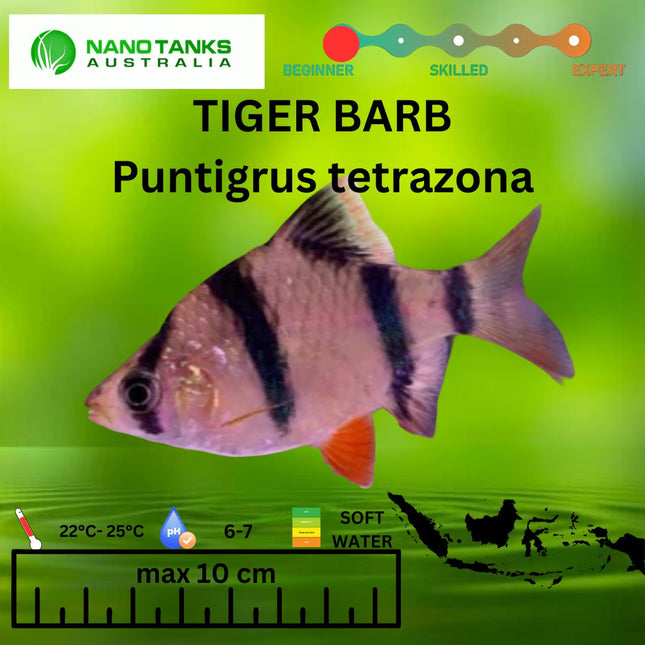
Appearance Tiger Barbs have an iconic look that even novice fish-keepers will instantly recognize. The body of the fish is quite wide. It’s tallest at the middle point and tapers down to a triangular-shaped snout. These fish are also quite colorful and have a very distinct pattern. The base color of Tiger Barbs is usually golden yellow. Some also have subtle rose gold tint. On top of that base color are several stripes. Care Tiger Barb care isn’t too difficult and can be handled by aquarists without much experience (assuming you stick to the recommendations in this guide). Otherwise, they wouldn’t be as widespread as they are! In general, these fish are relatively hardy and can adapt to simple setups as long as you cover the basics. That said, there are some aspects of their care that’ll require a bit of special attention. Despite their small size and beautiful looks, their strong personalities can be a handful! Here are the main care recommendations you need to know. Tank Size The minimum tank size for a small group of Tiger Barbs should be at least 20 gallons. However, we recommend going with a 30-gallon tank if you can. As we mentioned earlier, these fish are avid swimmers. The more room they have, the better. Plus, ample room to swim may help stave off aggressive behavior. Water Parameters In the wild, you can find Tiger Barbs inhabiting lakes, streams, and swamps that are lined with trees. Thanks to the decaying plant matter in the water, conditions tend to be more acidic. For the best results, you need to mimic their natural environment as closely as possible. That includes getting the water conditions just right. Luckily, the Tiger Barb can tolerate a generous range of conditions. As long as you stick within the following ranges, your fish should have no problem staying healthy. Water temperature: 68°F to 82°F degrees (aim for around 74°F if possible) pH levels: 6.0 to 8.0 (a slightly acidic 6.5 is best) Water hardness: 4 to 10 dKH To ensure that the aquarium has the proper water parameters you should invest in a reliable and accurate test kit. This will help you have confidence in the readings you’re getting, allowing you to make the right adjustments when necessary.
$6.00

Bichirs are fish from the Polypteridae family, and they're a sister group of ray-finned fishes. They have developed similar characteristics like two functional lungs, as well as Ampullae of Lorenzini - organs that can sense electricity or electroreceptors. It is worth noting that there are about 12 species in this genus recognized as Bichirs all living in freshwater systems found only in Africa's tropics. These large and aggressive animals need tanks with sufficient space to accommodate them; it is recommended for inexperienced aquarists because they require special attention due to their carnivorous diet and tank conditions (elements which may not be easy to fulfill). The specimens you encounter available on the market are caught mostly by fishing boats instead of being commercial bred (not many breeders exist yet).
$500.00 $350.00

Tiger Guppies are a popular type of tropical fish. Tiger guppies have an orange body with black stripes, and their fins are usually orange and black as well. These fish are relatively easy to care for and they can be found in most pet stores. They are active swimmers and do best in tanks that have plenty of plants and hiding places. They are peaceful and make a great addition to any aquarium.
$30.00

Oscars come from Brazil, Columbia, Ecuador, French Guiana and Peru. They can be found along the Amazon River and its surrounding areas, which is one of the most bio diverse environments in the world. This is a species full of personality. A few different varieties have been bred which offer some different colours and patterns. Oscars are territorial, so adding them to your tank can be risky. They aren’t afraid to attack other fish and will do so if a fish encroaches on their territory. Mating and feeding times can also fuel their aggression. Most of their time will be spent swimming in the mid-levels of the tank, though they’ll often head down to the substrate in search of food. You might see them uproot plants and decorations during this search, so everything in the aquarium should be secured down. The good news is that if the tank is setup correctly and you choose the right tank mates, their aggression can be controlled. Most Oscar varieties grow to be large, reaching up to 30cm. They reach this size quite quickly in their lifetime. Oscars can be kept together, and this is usually the safest option. Their need for territory can cause them to attack tank mates. Make sure they have lots of space as this reduces territory disputes. Whilst it can be difficult to find suitable tank mates for Oscars, providing a healthy diet is not. They’re omnivores and will eat pretty much anything you give them. In the wild, they would eat small fish, larvae and small pieces of plant debris. Small insects and crustaceans would make up the largest part of their diet. In an aquarium, the simplest option is to use flake/pellet foods. These have been designed to contain all the nutrition your fish need, you can even buy some specifically for cichlids. Other options include live/frozen foods (which are full of protein). These include bloodworms, brine shrimp and daphnia. Live foods encourage Oscars to catch their food which brings out their natural hunting instincts. Though they might nibble at plants, this won’t be a large part of their diet if you’re feeding them enough of other foods. Oscars require more care than most other species. Their size and large appetite means that they produce a lot of mess. This makes regular cleaning very important, or conditions will deteriorate quickly. Perform 20-25% water changes at least once a week, ideally twice. These cichlids are hardier than most fish, so they don’t get sick often, but they can get ill like all species. Species – Astronotus ocellatus Common Name – Albino Red Tiger Oscar Cichlid Origin – South America; Brazil, Columbia, Ecuador, French Guiana and Peru. Diet – Omnivore PH Range – Prefer Neutral but can be 6.5 – 7.5 Temperature – Tropical 26–28°c Breed Type – Egg layer Current Size – approximately 5cm (Grows to approximately 30cm) Sex – Un-sexed
$25.00
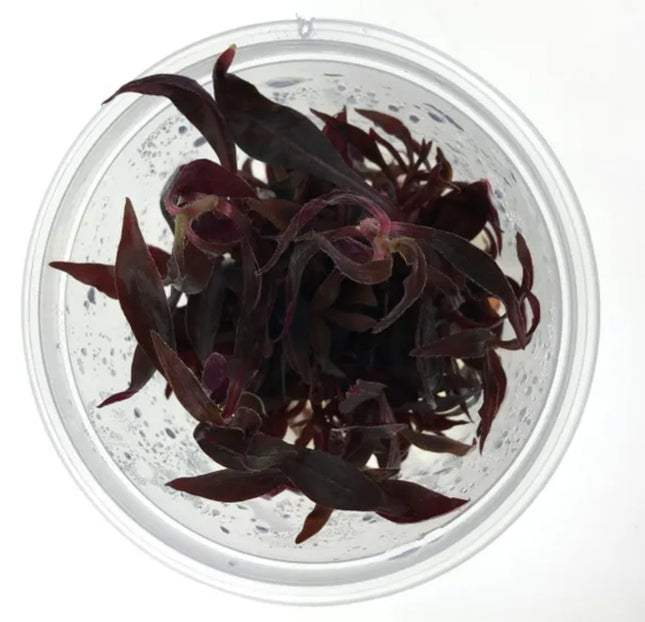
Aquarium plant from tissue culture in closed cup. This miniature version of the well-known Alternanthera is characterised by compact growth and a slower growth rate. It is particularly suitable for small aquariums or as a foreground plant in larger aqua scapes. By careful trimming can you create a dense, red-violet carpet approximately 5 to 10 cm high. High light intensity and addition of CO2 improves the plants growth and overall appearance. Plant information Type: Stem Origin: Cultivar Growth rate: Medium Height: 5 - 10+ Light demand: Medium CO2 : Medium Reference: https://tropica.com/en/plants/plantdetails/Alternantherareineckii'Mini'(023CTC)/4439 Please note that Pisces has omitted the 'mini' label in their recent labels. However we are assured these are still the mini variety
$14.95
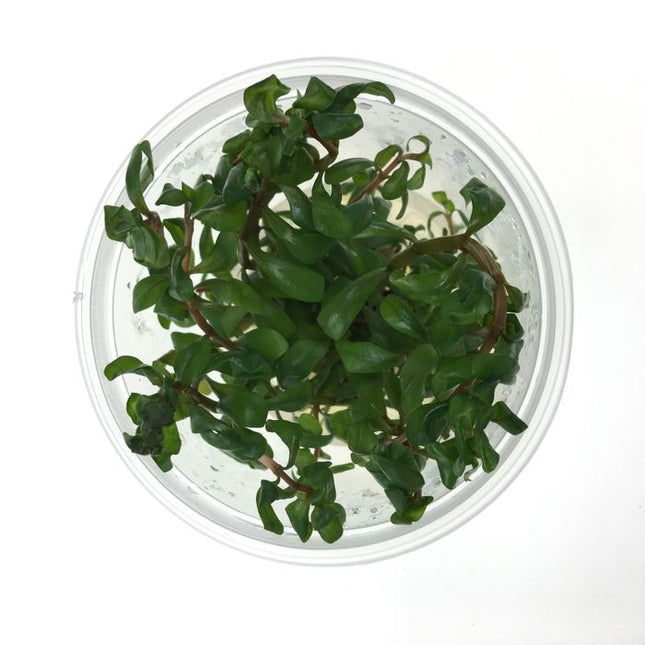
Grows to an average height of 16 - 20 inches (MID to BACKGROUND) The width of each stem is about 2 to 4 inches, based on leaf growth High lighting (3 - 4 watts/gal) Optimum growth temperature is 71.6 to 82.4 degrees Ammania Senegalensis needs nutrient rich water and substrate to do well in the aquarium. The color is almost an orange red, and propagation is by cuttings, which should be at least 10 inches long. Ammania Senegalensis needs a lot of light to do well. The width of each stem is about 2 to 4 inches, based on leaf growth. The leaf is curved in a downward fashion in an arch. In order to achieve strong shoots the substrate should be nutrient rich and light intensity high. Five to eight strong specimens can be used for the midground area to help accent the shades of green aquarium plants. Ammania Senegalensis does much better in soft water. Can withstand temps from 53.6 to 86 degrees. Optimum growth temperature is 71.6 to 82.4 degrees. Ammania Senegalensis requires high lighting (3 - 4 watts/gal) to do well. If kept in low-light tanks the leaves take on a dirty brown color. Separate each stem and plant individually. This will result in better growth and the lower leaves will still receive some light as the this aquarium plant grows taller.
$14.95
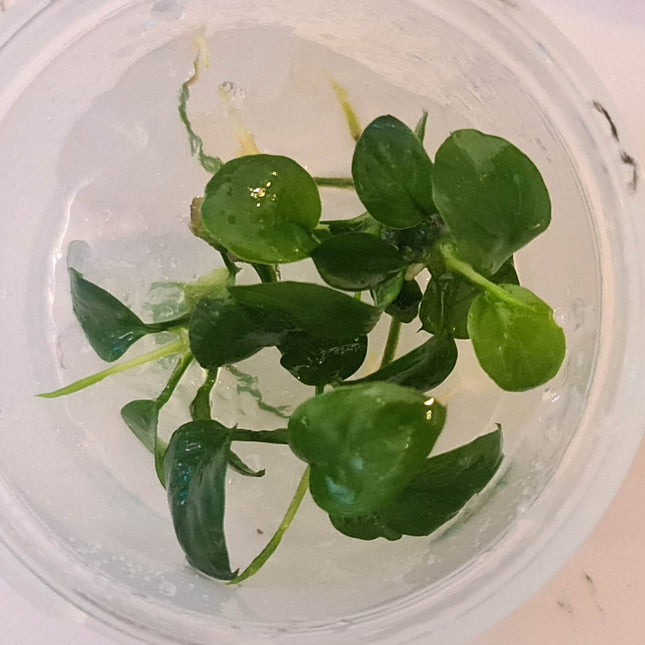
Anubias Gabon is another species in the Anubias family. Like other Anubias it can grow in a multitude of environments varying from aquariums to terrariums. Its stems are slightly longer when compared to Anubias Nana but the overall shape and characteristics are similar. This plant is suitable as a midground and background choice in a planted aquarium tank. This variant is a flowering plant that grows best when the rhizome is attached to a hard surface such as wood or stone. It benefits from consistent fertilization but light requirements are minimal as its leaves are susceptible to algae growth when placed under high lighting. CO2 is optional but can promote faster growth and robust leaves when used. Common Name Anubias Gabon Care Easy Lighting Low CO2 Optional Suggested Placement Attach to wood or stone Propagation Separate rhizome Growth Rate Slow Leaf Size 3" Tissue culture plants are grown in-vitro by laboratories who specialize in propagating aquatic plants. There is a huge selection of plant species that have been propagated this way. This is truly the best option for those who want absolutely zero unwanted pests, algae and pesticides. This makes them perfect for shrimp keepers and any planted tank enthusiasts alike.
$24.00
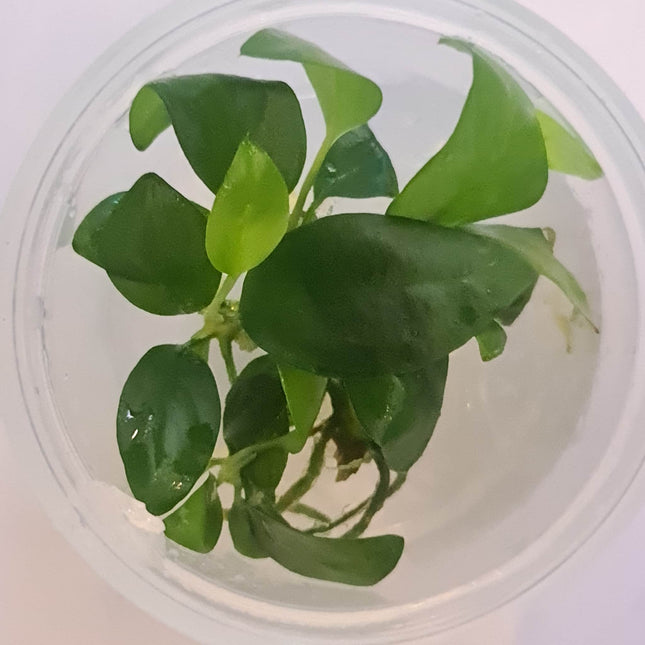
Common Name: Anubias Hastifolia Anubias Hastifolia is a unique variant of Anubias which can be distinguished by the arrowhead-shaped leaves. Like other Anubias it can grow in both aquariums and terrariums either submerged or emersed. It has slightly longer stems compared to smaller variants such as Anubias Nana or Congensis which makes it suitable for the midground or background of an aquarium. Like other Anubias, this variant is a flowering plant that grows best when the rhizome is attached to a hard surface such as wood or stones. They have low to medium light requirements and can benefit from regular fertilization. CO2 is not necessary but can promote faster growth and more robust leaves. Since its a slow grower, the leaves are susceptible to algae growth if placed under high lighting. Propagation is easy and straightforward; simply cut or pull apart rhizomes to be replanted. Make sure to keep the rhizomes above your substrate or the plant can begin to rot. Notes: Anubias are strong plants that can thrive in a variety of environments. These epiphytes can be planted into substrate or attached to hardscape. Do not make drastic changes to the aquarium. Unstable parameters will result in melt and rotting of the aquarium plant. Please be sure to remove this plant from its pot. For instructions on how to properly prep aquarium plants, click here. CO2 injection and quality aquarium soil will yield better growth. Please research appropriately to ensure your plant thrives. Family Name: Araceae Origin: West Africa Height: 6-16" pH: 6-7.5 Care: Easy Light: Low Co2: Not necessary Propagation: Separate by rhizome Growth rate: Slow to moderate
$30.00
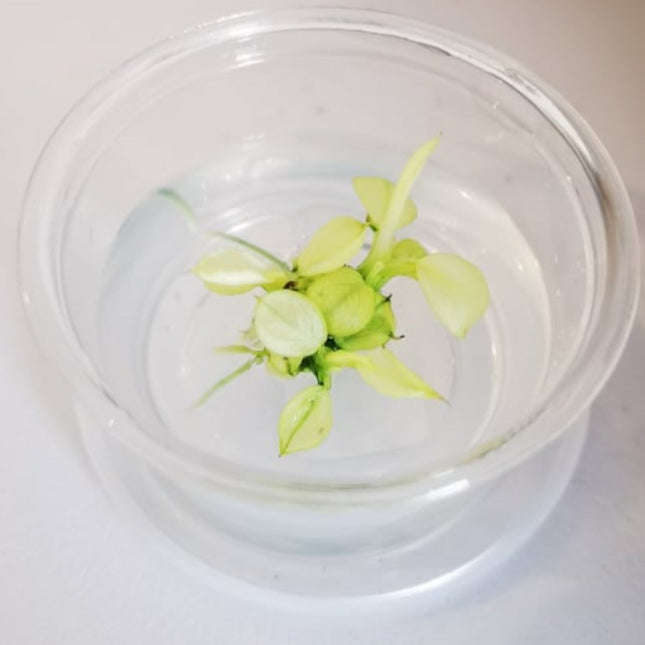
Anubias Pinto, also known as Anubias Marbled White or White is a variant of the commonly seen Anubias species. Its extremely unique colouring was derived from the normal green Anubias population through the use of very particular selection. Each leaf slightly differs and the amount of the marbled effect present will vary. This specific variant of the Anubias plant is also slow growing but requires more light than its other Anubias counterparts in order to thrive. Similar in size to Anubias Nana Petite, Pinto makes for an uncommon but unique addition to any planted aquarium from nano tanks to larger standard sized tanks. Their interesting coloration provides a wonderful contrast and pop of colour against darker aquascaping stones, aquarium driftwood and other aquatic plants. Since this is a tissue culture stock it means there are no risk of introduction of algae or snails
$69.95
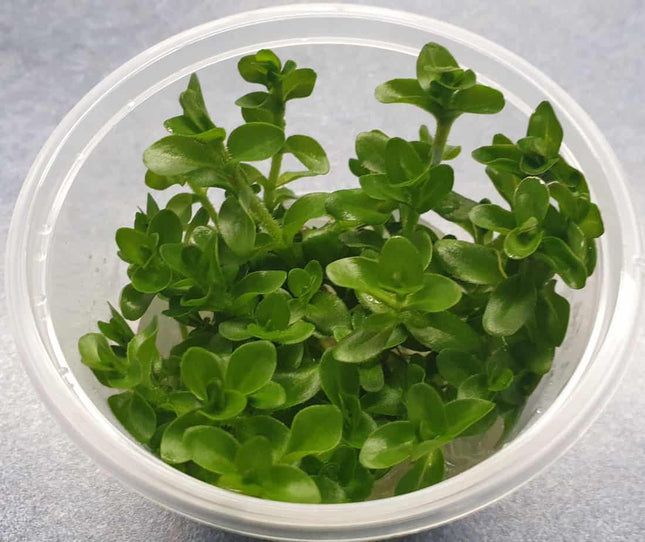
Bacopa Amplexicaulis; Family: Plantaginaceae Origin: North America pH: 6.0 – 7.8 Temperature: 18 – 28° C Height: 10 – 40cm Lighting: Low to Very High
$14.95
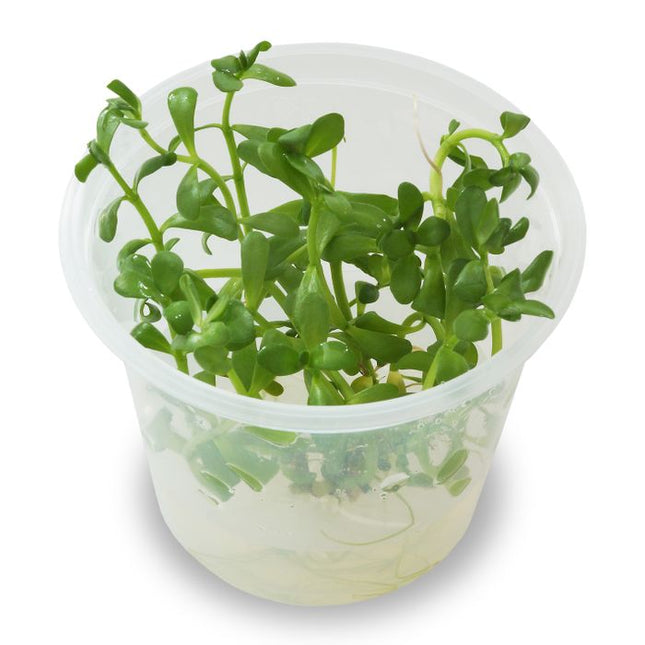
Plant info Type: Stem Origin: Cultivar Growth rate: High Height: 3 - 10+ Light demand: Low CO2 : Low This plant has been used as a medicine for humans but in the fish tank it can be kept within the aquarium or as an immersed plant The plant itself has a pleasant smell and has nice blue flowers during spring. This is also the Tissue Cultured variety and due to that there are no issues with algae or snail introductions
$14.95
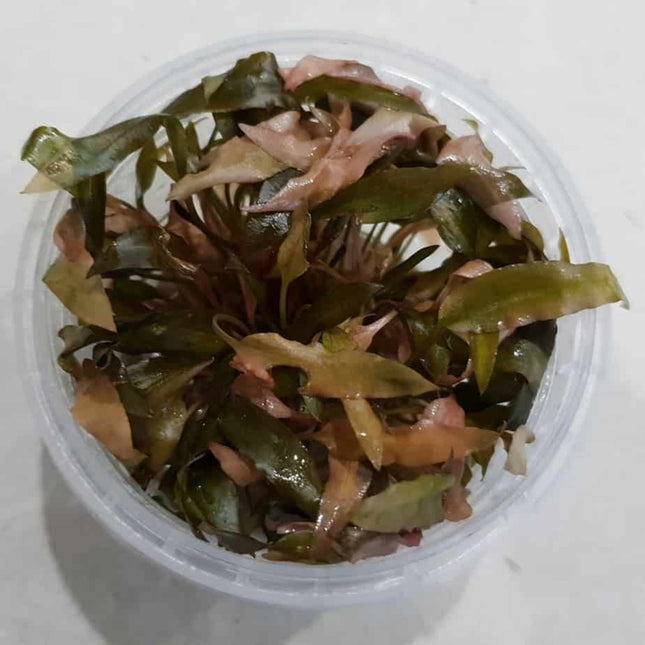
Hardiness: Very EasyLight Needs: LowPlant Structure: RosetteFamily: AraceaeGenus: CryptocoryneRegion: AsiaLocation: Sri LankaSize: Height: 12-50cm (5-20in)Growth Rate: MediumCan Be Grown Emersed: Yes
$14.95
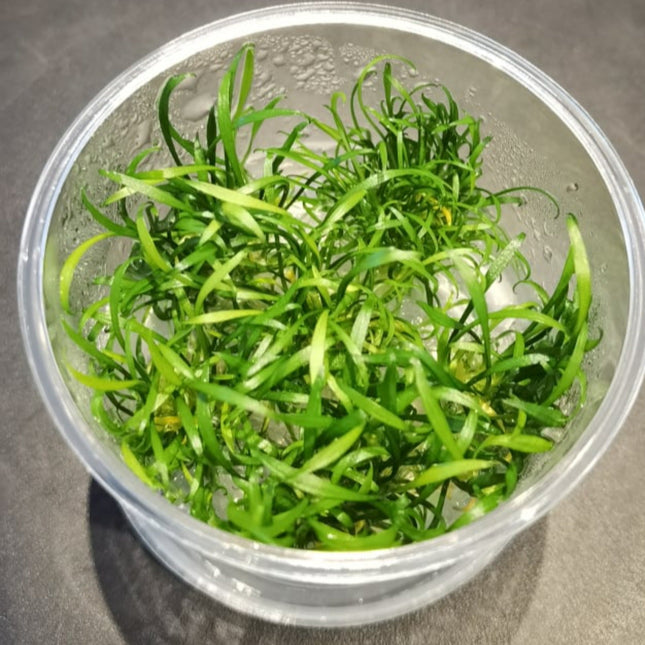
Cryptocoryne Parva is one of the smallest species of Crypts. It has green, grass-like leaves which can grow up to 4” tall, making it a suitable foreground and mid ground plant. Compared to other Crypts, it has a very slow rate of growth and can require more light. Cryptocoryne Parva is extremely slow growing and will require patience to achieve lush growth! Notes: Cryptocoryne prefer not to be moved once planted. If possible, do not move them! Do not make drastic changes to the aquarium. Unstable parameters will result in melt and rotting of the aquarium plant. Please be sure to remove this plant from its pot. Remove the cotton surrounding the roots and plant into a quality substrate. For instructions on how to properly plant "potted" aquarium plants CO2 injection and quality aquarium soil will yield better growth. Please research appropriately to ensure your plant thrives. Family Name: Araceae Origin: Sri Lanka Height: 2-4”” pH: 6-7.5 Care: Easy Light: Low Co2: Not Required Propagation: Separate by Rhizome Growth rate: Slow to Moderate
$29.95
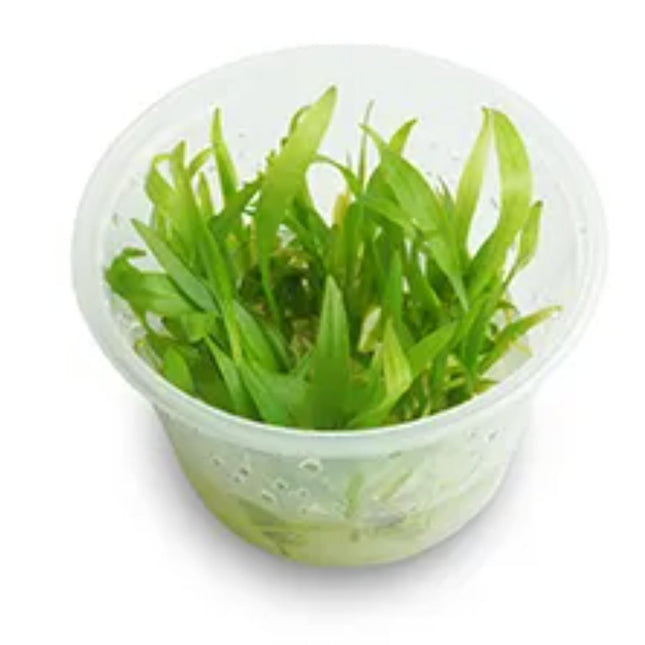
Family: AlismataceaeCommon Name: Chain SwordOrigin and Habitat: Neotropical; reported from areas in Mexico, Central America, West Indies, and South America down to northern Argentina.Ideal position in aquariumA fore-ground and mid-ground plant in large tanks, or background in smaller tanks.Lighting requirementsModerate; under brighter light the leaves will be smaller [see additional comments under Physical Description].Growth rateMediumMinimum Tank SuggestionN/AWater parameters for Chain SwordSoft to moderately hard (4 to 15 dGH), acidic to basic (pH up to 7.5), temperature 22-30C/72-86F.
$17.95
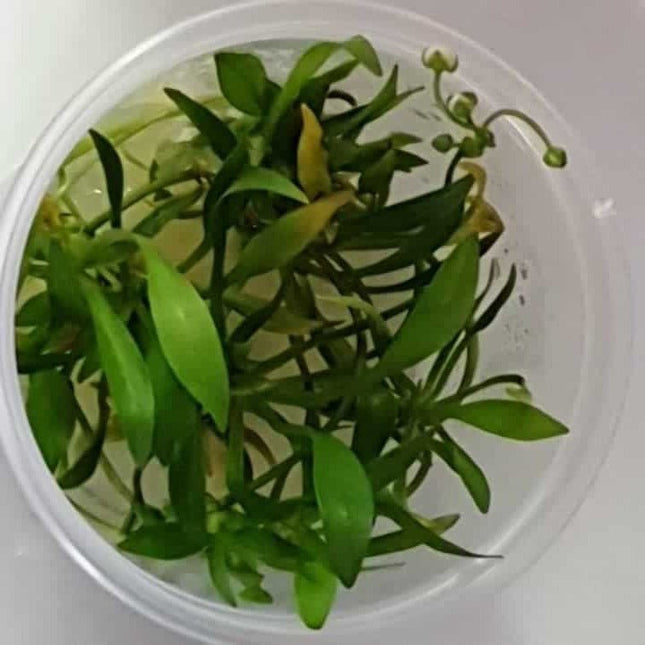
SMALL 1909 Common Names: Amazon swordDivision: MagnoliophytaClass: LiliopsidaOrder: AlismatalesFamily: AlismataceaeNative Distribution: Central and South AmericaAquarium Placement: BackgroundRequirements: Adaptable to a wide range of conditions Description:The Amazon sword has been widely used in the aquarium hobby for decades. Until recently, “Amazon sword” was the common name for a few larger Echinodorus species found in or near the Amazon River Basin, specifically E. amazonicus and E. bleherae. However, based on DNA testing done in 2008, those former species are now considered to be synonymous with E. grisebachii. For more data on that, refer to Kew Bulletin Vol. 63: 525–563 (2008). Amazon sword species can vary greatly in appearance and the conditions in which they grow. They can tolerate soft or hard water in a wide range of pH values, and temperature is not overly important, as long as it is kept in a reasonable tropical range. While the two most common Amazon swords have been grouped into a single species, there is still some difference in the conditions tolerated by them and their growth. The former E. amazonicus, for example, prefers softer water and reaches a shorter height of 16 to 20 inches. The variety formerly called E. bleherae, on the other hand, will tolerate hard water and can reach over 20 inches in height and girth. Amazon swords of all kinds prefer a deep substrate of at least 4 inches to accommodate a massive root system. However, this is only needed when the plants will be grown with moderate to high light and supplemented with nutrients. In a low-light tank, the plant will grow very slow and not fully develop such a large root system, although it will still benefit from a supplemental root fertiliser. Use in Aquascaping: Echinodorus grisebachii is best suited to the background of very large aquaria. However, many hobbyists use it as a focal point in the mid ground of the aquascapes. Its large leaves provide good contrast to smaller-leaved plants, which would include the majority of aquatic species. The leaves have a rich green colour and can often exhibit some red/bronze coloration in newly emerging leaves. In some fish-dominated aquaria, where a group of swords may be the only significant plants, Amazon swords have been known to be the preferred breeding spot for certain egg-laying cichlids such as angelfish. The large and wide leaves can provide shelter and even territory for many fish. Perhaps a less publicised use for this plant, yet just as important, is for hiding unsightly aquarium equipment in the aquascapes. Heaters, filter intakes, cords hanging over the edge of the tank, thermometers, etc., can all be effectively concealed by the large and densely leaved sword plant. Propagation: Amazon swords can be propagated by splitting a large plant into smaller plants by removing it from the substrate and carefully cutting the crown. They also send up submersed stalks, upon which several plantlets will form. These plantlets can be removed after they begin to form roots. If the stalk is left attached to the mother plant, it can produce many baby swords over a long period of time. With high lighting or very humid outdoor conditions, these swords can also be flowered and pollinated with a cotton swab or soft brush. Once the seed matures, it can be harvested and sown to produce new emergent plants Reference: http://www.tfhmagazine.com/details/plant-of-the-month/echinodorus-grisebachii.htm
$14.95
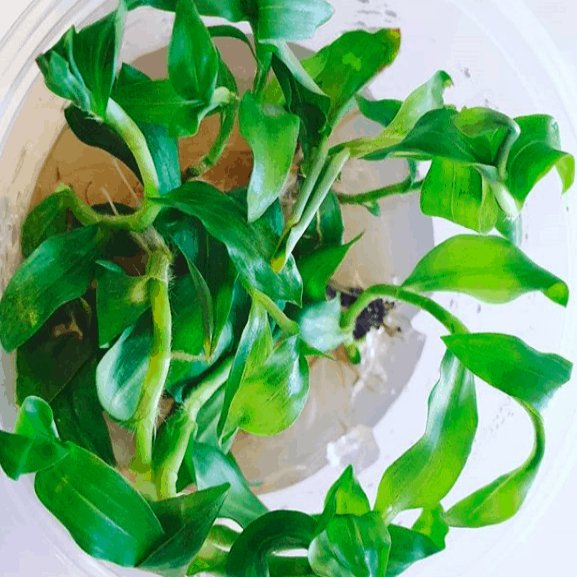
Being a perennial herb they can grow immersed or submersed. The stems grow to around 20-70cm long and the stems creep along the ground and will also send area shoots as well. The plant is harvested from the wild as a medicinal herb and occasionally used as a supplement in its native New Guinea. Range East Asia - China, Indian subcontinent, Myanmar, Thailand, Laos, Vietnam, Indonesia, Philippines, Australia Habitat Grassy ravines, forests by the water; from near sea level to elevations of 1,700 metres. In wet places, along streams, in low and medium elevations in the Philippines Habit PerennialHeight 0.50 mCultivation Status Cultivated, Wild In the aquarium these are grown as a tissue culture and as such there won't be any introduction of algae or unwanted snails.
$14.95
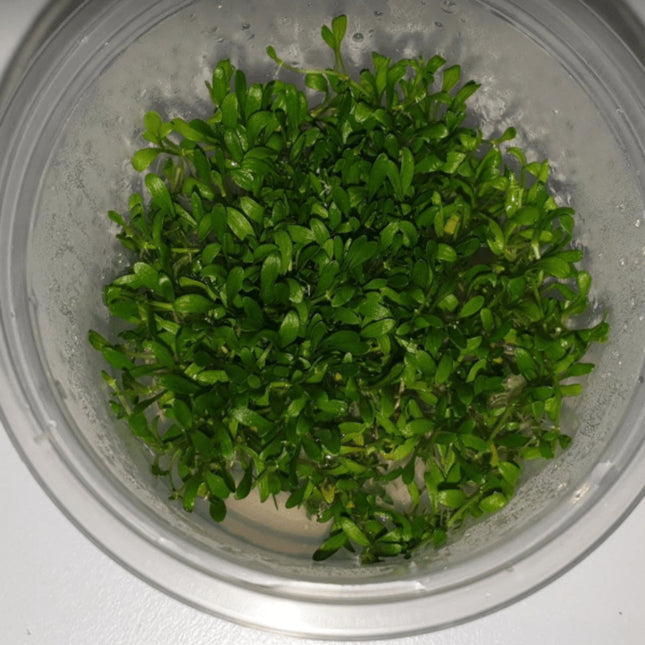
Glossostigma elatinoides from New Zealand is much in demand in Japanese-inspired aquariums. It is one of the smallest aquarium plants (2-3 cm tall), and thus a good foreground plant. A difficult plant demanding a lot of light. Grows upwards if light is poor. Make sure larger plants do not overshadow it. When planting in the aquarium small clumps (approx. 1/8 pot) should be placed at intervals of a few centimetres to help the plants grow together more quickly. CO2 addition and soft water promote growth significantly. Type: Carpeting Origin: Australia Growth rate: High Height: 3 - 5+ Light demand: High CO2 : High Reference: Tropica
$17.95
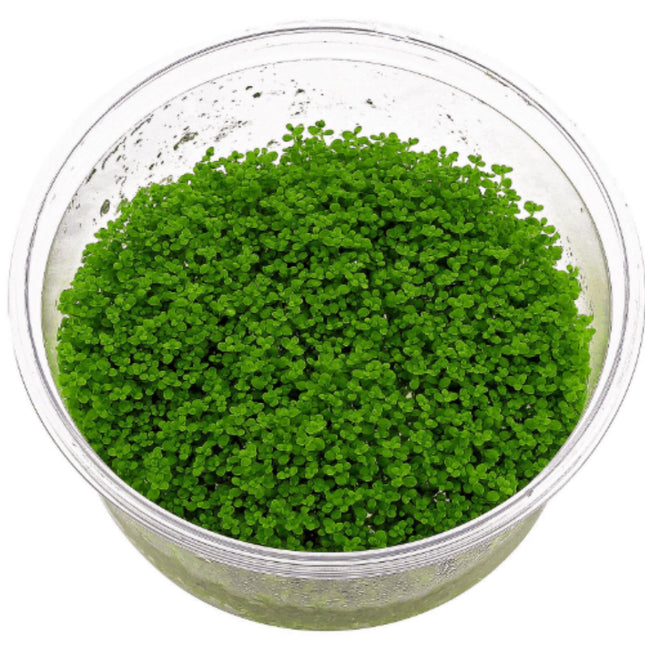
Dwarf Baby Tears Plant (Smallest Aquarium Plant) Overview: The dwarf baby tears plant is a uniquely challenging aquarium plant that has gained popularity among aquarists. For those of you who are unfamiliar with this species, it's important to note how tiny and versatile it can be in the aquatic environment: perfect for nano tanks or as an accent piece on larger aquariums! Dwarf Baby Tears Plant (Hemianthus Callitrichoides Cuba) is rather challenging to keep, but a very good looking aquarium plant. This ground-covering is one of the smallest plants available and one of most wanted by aquarists. The low profile makes them perfect for front planks on nano tanks; they're also great as accents in other more sizable setups! Origin: In the summer of 1996 at Tropica's headquarters in Las Pozas, Holger Windelov noticed a small plant that had been growing near his office for some time. After investigating further he discovered it was one of two new species called Hemianthus callitrichoides. Being surrounded by large stones and a water level of about 50 cm high made this discovery quite an adventure! In response to the wet and humid conditions, Hemianthus Callitrichoides Cuba forms thick green glades which provide a sense of security in this otherwise dangerous habitat. The water flow is strong during rain seasons but these plants are resistant to it up until they reach 1 meter deep into their environment. Since 2003, this plant has been a favourite among hobbyists who want to create naturalistic aquascapes that appeal to their inner fish. Specification: The Hemianthus callitrichoides are miniature copies of that of the more common hemiantus micranthemioe. They form small glades about 3-6 cm high, differing from their counterpart in smaller leaves and shorter stems. Difficulties in keeping The Hemianthus callitrichoides «Cuba» plant is challenging to keep, but if you are willing to put in the time and effort it will be worth your while. The high demand for minerals makes them a bad choice for beginner aquarists because they have a hard time keeping up with such an extensive list of needs. These plants require small-grained substrate as well as strong lighting from artificial CO2 supply that must also include fertilization during its growth cycle. In order to ensure that your dwarf baby tears plants are not crowded out by the neighbouring fast-growing plant, it is important for you to trim and thin them regularly. Care The plant, which is tolerant to the condition of little or no light and can still grow successfully in these conditions, will instead elongate at such a lack. If there's never any sun whatsoever then it won't even develop anymore until you have bright lighting again--even if that means having some extra lamps on for now! The stronger your lights are, the thicker their carpet becomes; with stems tightly wrapped around each other when they're under strong illumination. This plant has its own requirements as far as fertilization goes: especially ferrum content in water needs to be considered because without enough fertilizer leaves become pale and small due to high demand by this particular species. That’s why iron-containing liquid fertilizers should always be used precisely Dwarf baby tears plants are remarkable for their ability to quickly restore colour after being submerged in water. This makes it an excellent indicator of the iron content within a tank's surface, as well! With optimal conditions such as CO2 supply and an ideal temperature between 20-28°C, this plant can be grown without much difficulty--though if you don't have these luxuries then just adding them into your aquarium is enough to enjoy them at its full potential FAQ Can Hemianthus Callitrichoides Cuba live without CO2? CO2 is paramount to HCC success - even though this plant-primarily thrives on elevated carbon dioxide levels, these few sensitive ones also serve as excellent living indicators by changing their growth pattern depending on what kind of care they need: more sparsely spaced leaves growing higher up from the ground
$14.95

Hydrocotyle tripartita is a fast-growing aquatic plant native to Southeast Asia. It has small round leaves that are arranged in three leaflets. This aquatic plant can grow in many different environments, including aquariums and ponds. It has a tendency to spread, making it an ideal choice for ground cover or carpet-like vegetation in the aquarium. It is also known to be a great oxygenator and will help keep the water clean and clear. Hydrocotyle tripartita is an easy to care for plant, requiring only minimal light and regular trimming.
$14.95
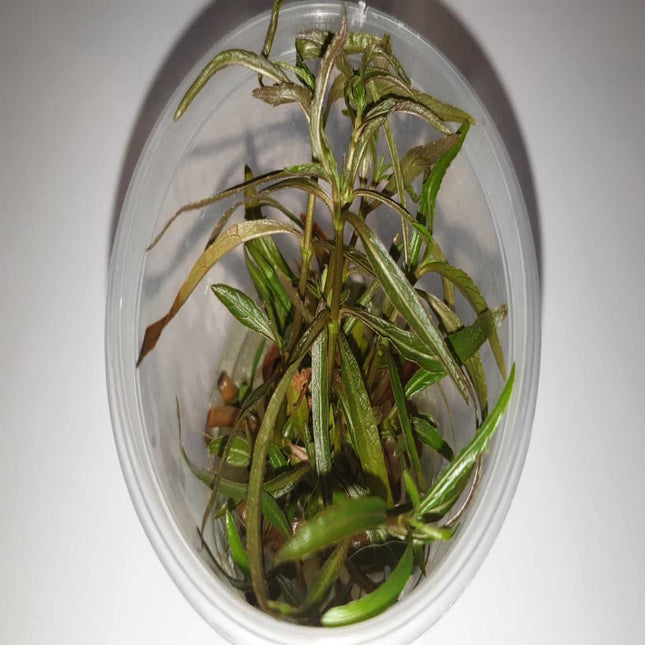
Hygrophila Angustifolia, also known as the Willow Hygro, is an undemanding, extremely attractive aquarium plant. It has large stems with narrow leaves that sway in the current like a weeping willow tree. Hygrophila angustifolia grows fast and helps keep aquarium water clean by removing nitrates, making it an ideal choice for the new aquarist. It requires a nutrient-rich substrate, with iron-rich fertiliser added regularly. Provide a moderate amount of lighting of at least 2 to 3 watts per gallon of full spectrum (5000-7000K) light. CO2 fertilisation is also recommended. For Hygrophila Angustifolia to thrive, the water should be kept between 74°-82°F, with an alkalinity of 3 to 8 dKH and a pH of 6.5-7.5. To propagate, plant cuttings that have been removed from the healthy mature plant. Simply remove any leaves from the bottom 1" to 2" of the stem, and new root growth will form from the last node on the stem. Care Level: Easy Colour Form: Green, Yellow Water Conditions: 74-82° F, KH 3-8, pH 6.5-7.5 Max. Size: 1' 8" Family: Acanthaceae Lighting: Moderate Supplements: Trace Elements, CO2 Fertilisation, Iron-Rich Fertiliser, Substrate Fertiliser Placement: Background Propagation: Cuttings
$14.95

Lobelia cardinalis grows wild in Northern America. In the nursery this plant is cultivated in marshy conditions, forming dark-green leaves which are purple underneath. In aquariums the leaves turn a beautiful shade of light-green, with stems 10-30 cm tall and 5-10 cm wide. Widely used in Dutch aquariums in so-called "plant streets''. In open aquariums it grows above the water surface, where it forms very beautiful scarlet flowers and the leaves regain their colour. Can be used in garden ponds Plant info Type: Stem Origin: North America Growth rate: Medium Height: 20 - 30+ Light demand: Low CO2 : Low Reference: https://tropica.com/en/plants/plantdetails/4494/4494
$14.95
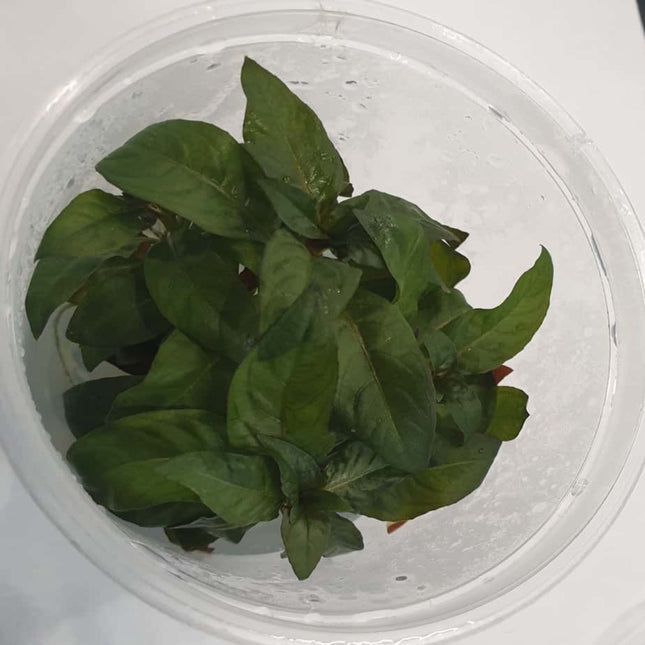
Ludwigia glandulosa from North America is a very beautiful water plant. It is slow growing and requires CO2 addition to grow well. Stems becomes 15-40 cm tall and 5-12 cm wide. The leaves turn greener and the lower ones may fall off if sufficient light is not provided. Used to be sold as Ludwigia perennis. Plant info Type: Stem Origin: North America Growth rate: Medium Height: 15 - 30+cm Light demand: Medium CO2 : Medium
$14.95
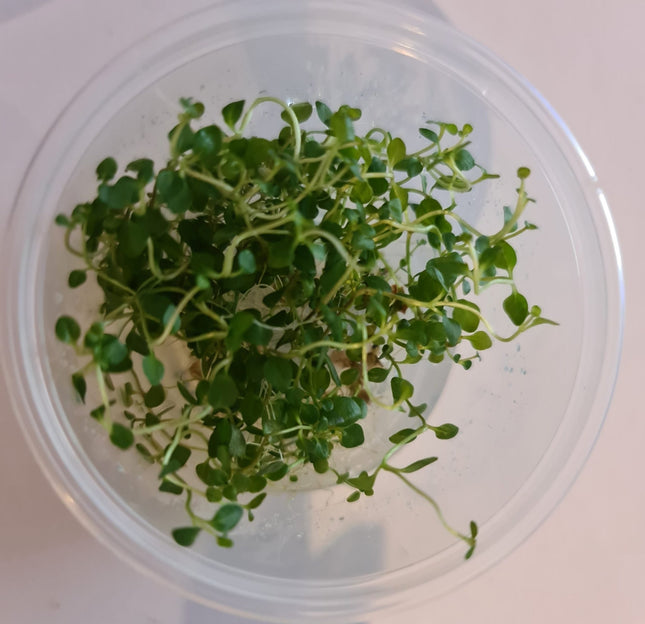
Lysimachia nummularia or Creeping Jenny is a vigorous, creeping, prostrate perennial with rounded green leaves and stems. It is ideal for boggy areas or alternatively if used as a ground cover can take some light foot traffic. When planted in borders it is usually chosen as an accent plant, but beware, because it can spread rapidly and crowd out other plants. It is also suitable for a bog garden or as an aquatic marginal plant. The cultivar Aurea (golden creeping Jenny) has yellow leaves, and is less aggressive than the species and has gained the Royal Horticultural Society's Award of Garden Merit. Soil: Moist, slightly acidic soils with plenty of organic matter. Maintenance: Propogate by seed or division. Diseases: None of note. Other Species: 150 species in the genus including the upright Lysimachia vulgaris with lovely yellow flowers. Comments: Circular foliage looks like coins - hence its name of Moneywort.
$14.95
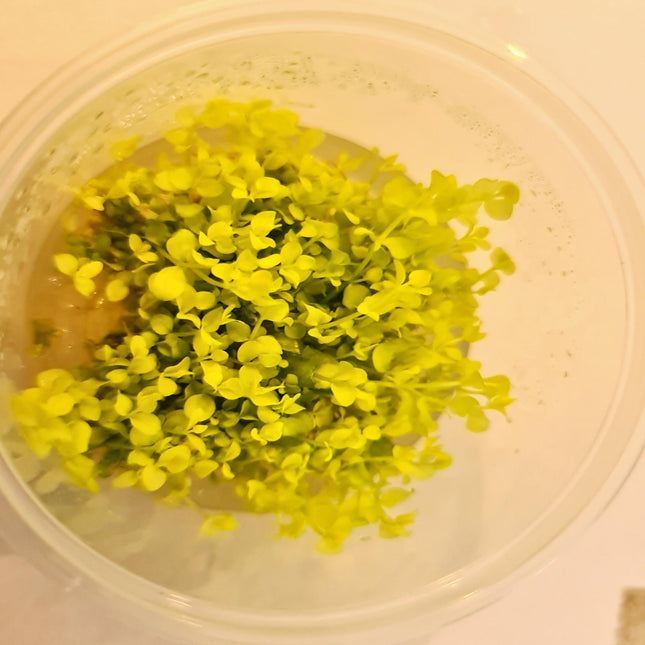
Ease of Care: Intermediate Position: Foreground Tissue cultures are in a 5cm container - simply rinse gel and plant. Pisces Enterprises Tissue Culture Plants have been grown in sterile laboratory conditions producing premium quality plants free from algae, pesticides and pests. Sold in food grade plastic pots, our Tissue Culture Plants are grown in a unique nutrient rich agar jelly. Easy to sell, the plants do not require watering and will continue to grow provided they are sealed and have sufficient light. Pisces Tissue Culture Plants will grow in fresh water aquariums, aquascapes and terrariums. Because of the wonderful qualities of these plants, they have grown, and continue to grow in popularity with Australian hobbyists. In ideal conditions, shelf life will be approximately 4 weeks. Basic care instructions: Do not remove lid or contamination will occur Keep in well lit area Storage temperate should not exceed 30°C
$14.95
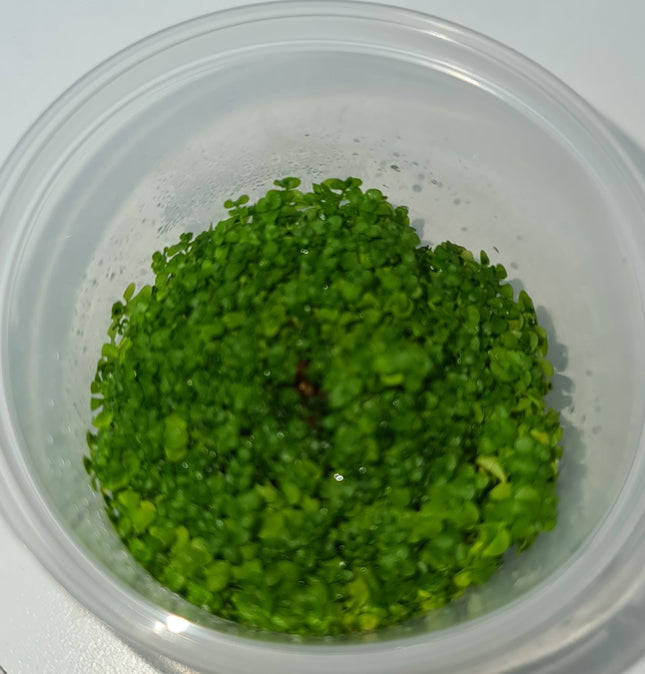
Micranthemum umbrosum is native to most southeastern US states, from Texas to Florida and Virginia, where it grows in ponds, ditches and rivulets, in many areas it is emersed in summer and submersed in winter. It is also found in parts of Central and South America. The Shade mudflower may be known in the hobby for quite some time, but has gained popularity recently since aquaria that meet this plant's requirements have become more common. Sometimes M. umbrosum has difficulties adapting to a new environment, but once acclimated it is not a very demanding plant, apart from its hunger for light. A relatively strong lighting of at least 0.5 W/L is required for good growth. A lack of light results in the plant throwing off its lower leaves, or in holey leaves. At the same time, the stems become brittle and tends to break, so small pieces of the plant drift to the surface where light is more intensive. This plant may be cultivated without additional CO2 injection, however, its growth rate decreases significantly, and the leaves grow smaller. If the basic requirements of M. umbrosum are met, it is really easy to propagate. Just cut off a main shoot somewhere on the stem and re-plant it in the substrate, it will grow new roots very quickly and form a stand-alone plant after a very short time. M. umbrosum tends to throw a large number of new lateral shoots, which develop in the leaf axils some centimetres below the top of a main shoot. If you cut back the plant you can further this development even more, and by frequent trimming you can create rather dense plant mats. Emersed cultivation can further the growth rate even more, however, very moist air and a wet substrate are necessary for that. If these requirements are met, the plant grows quite profusely, and in its leaf axils, tiny white flowers develop, which look a lot like those of Hemianthus species. M. umbrosum is usually planted in the middle- or background of an aquascape. Extremely strong lighting may induce it to grow rather flattish and creeping, then it can also be used in the foreground of the aquarium.
$16.95
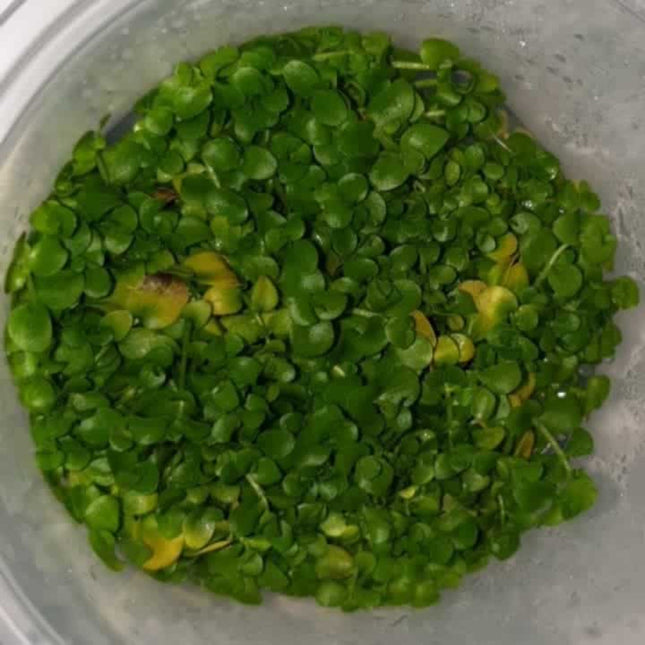
Micranthemum tweediei 'Monte Carlo' comes from Argentina. It has compact, round and fresh light green leaves on creeping stalks and creates a fast-growing carpet in the front of the aquarium. The plant can grow in light shadow, but requires good light conditions, as well as CO2 additive, in order to develop optimally and become really compact. Plant info Type: Carpeting Origin: South America Growth rate: Medium Height: 3 - 5+cm Light demand: Medium CO2 : Medium Reference: Tropica Website
$14.95
You have seen 1368 out of 1935 products